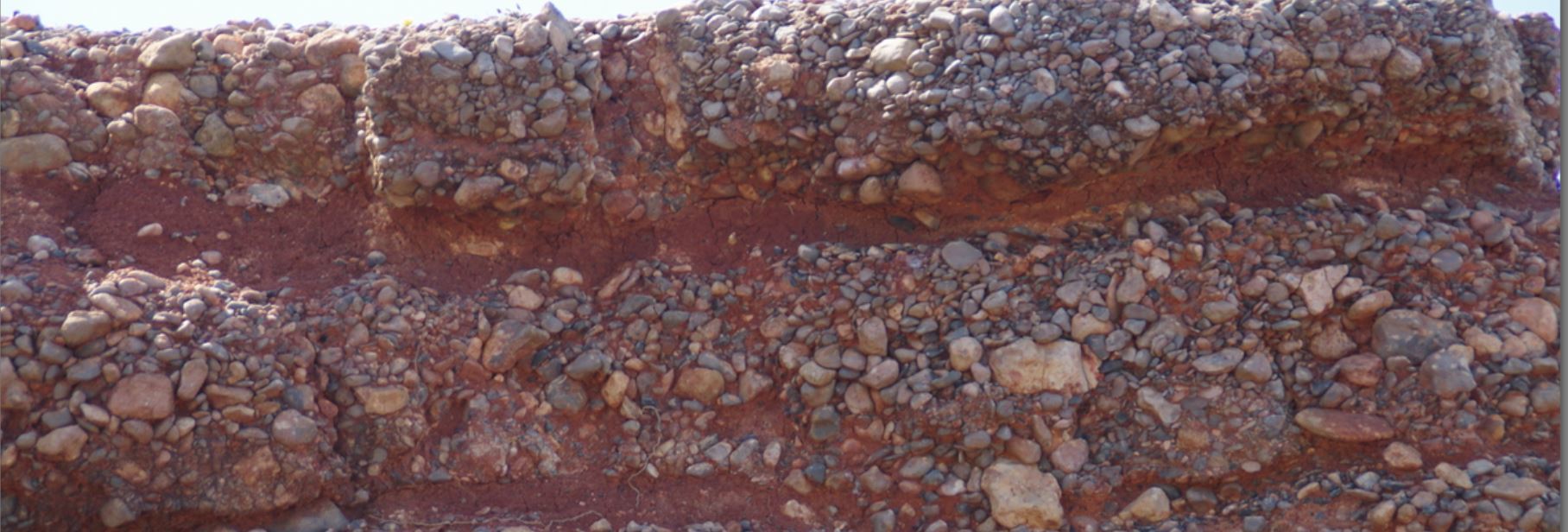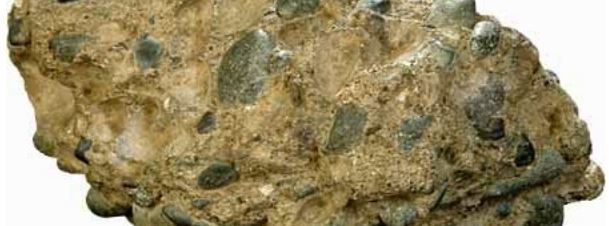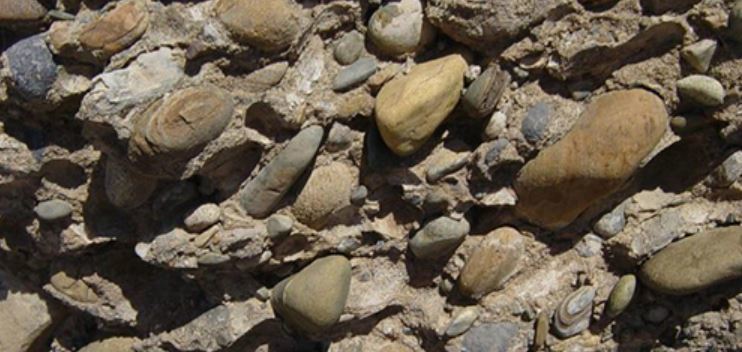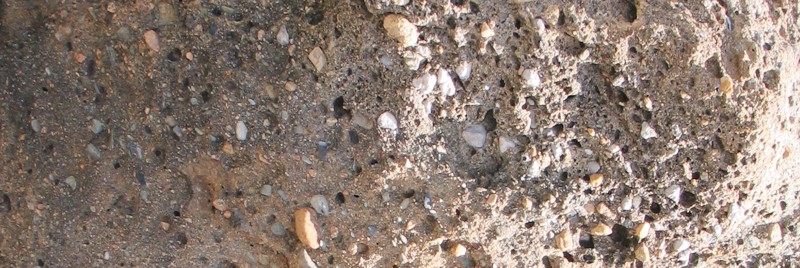In geology a simple explanation of what a conglomerate is might be that it is a rock consisting of individual stones, or clasts, that have become cemented together. Conglomerates are typical sedimentary rocks consisting of rounded fragments cemented in a matrix.

Conglomerates differ from breccias, which are similar in morphology but consist of angular clasts. Both conglomerates and breccias are characterized by clasts larger than sand (>2 mm; see below).

Characterising a conglomerate
Two distinctive varieties of conglomerates (and breccias) are defined on the basis of texture:
1 - Paraconglomerates consist of a matrix-supported rock that contains at least 15% sand-sized or smaller grains (<2 mm), the rest being larger grains of varying sizes, and

2 - Orthoconglomerates are defined by texture. They are a grain-supported rock that consists primarily of gravel-sized grains (~256 mm), with less than 15% matrix of sand and finer particles.

Conglomerates can be further classified on the basis of their composition of framework and matrix grains:
Intraformational- conglomerates and breccias have an interior (intrabasinal) source: that is; they are eroded from the same sedimentary rock unit they are a part, rather than being derived from rocks located outside the depositional basin. Consequently intraformational conglomerates and breccias have framework grains identical in composition to those in the matrix.
Extraformational- conglomerates and breccias are derived from sources areas outside the depositional basin. Detritus weathered from external sources is carried away and deposited elsewhere. As a result framework clasts differ markedly in composition from matrix.Framework matrix is exotic; that is, not derived by the erosion and redeposition of matrix material.

Oligomict or petromict?
In oligomict (orthoquartzose) conglomerates (or breccias), more than 90% of the framework clasts consist of fragments of only a few varieties of resistant rocks and minerals as quartzite, vein quartz, and cherts.
Inpetromict (polymict) conglomerates, clasts of many different composition of metastable and unstable rocks are abundant; for example, basalt, slate, and limestone. Generaly petromic conglomerates are much more abundant than oligomict orthoconglomerates and are mainly alluvium eroded from high-relief areas.
Geological setting
The Unit of interest is designated C3 in the Geological Map of Nazaré (Sheet 26 -B; Alcobaça) composed of a conglomerate with large clasts.

Claiming the earthcache
To validate your find in this EC, you MUST characterise the conglomerate at the cache coordinates using the above descriptions, i.e:
- Is it a ORTHOCONGLOMERATE or a PARACONGLOMERATE?
- Is it INTRAFORMATIONAL or EXTRAFORMATIONAL?
- Is it OLYGOMICT or POLYMICT?
Send me your answers via e-mail through my GC profile to validate your found.
Note: no SPOILER pics of the outcrop!
**********
Em geologia, uma explicação simples do que é um conglomerado pode ser que é uma rocha consistindo de pedras individuais, ou clastos, que foram cimentados. Conglomerados são rochas sedimentares típicas que consistem em fragmentos arredondados cimentados numa matriz.
 Os conglomerados diferem das brechas, que são semelhantes na sua morfologia, mas consistem em clastos angulares. Ambos os conglomerados e brechas são caracterizados por clastos maiores do que areia (> 2 mm; veja abaixo).
Os conglomerados diferem das brechas, que são semelhantes na sua morfologia, mas consistem em clastos angulares. Ambos os conglomerados e brechas são caracterizados por clastos maiores do que areia (> 2 mm; veja abaixo).

Characterização de um conglomerado (ou brecha)
1 - Os paraconglomerados consistem numa rocha suportada pela matriz que contém pelo menos 15% de grãos do tamanho de areia ou grãos menores (<2 mm), o resto sendo grãos maiores de tamanhos variados, e

2 - Ortoconglomerados são definidos pela textura. Eles são uma rocha sustentada por grãos que consiste principalmente de grãos do tamanho de cascalho (~ 256 mm), com menos de 15% de matriz de areia e partículas mais finas.

Os conglomerados podem ser ainda classificados com base na sua composição de grãos de estrutura e matriz:
Intraformacional - conglomerados e brechas têm uma fonte interna (intrabasinal): isto é; eles são erodidos da mesma unidade de rocha sedimentar da qual fazem parte, em vez de serem derivados de rochas localizadas fora da bacia deposicional. Consequentemente, os conglomerados e brechas intraformacionais têm grãos de estrutura idênticos em composição aos da matriz.
Extraformacional- conglomerados e brechas são derivados de áreas de fontes fora da bacia deposicional. Detrito intemperizado de fontes externas é levado e depositado noutro lugar. Como resultado, os clastos da estrutura diferem significativamente da matriz em composição. A matriz é exótica; isto é, não derivado da erosão e redeposição do material da matriz.
Oligomítico ou polimíctico?
Em conglomerados (ou brechas) oligomíticos (ortoquartzosos), mais de 90% dos clastos da estrutura da rocha consistem em fragmentos de apenas algumas variedades de rochas resistentes e minerais como quartzito, quartzo de veios e chertes.
Nos conglomerados polimítico, existem clastos de muitas composições diferentes de rochas metaestáveis e instáveis; por exemplo, basalto, ardósia e calcário. Geralmente, os conglomerados polimítico são muito mais abundantes do que os ortoconglomerados oligomíticos e são principalmente erodidos por aluvião em áreas de alto relevo.
Enquadramento Geológico
A Unidade de interesse é designada C3 no Mapa Geológico da Nazaré (Folha 26 -B; Alcobaça) composta por um “conglomerado com grandes clastos”. A idade da rocha é do Turoniano (Cretácico Superior; entre 93.9 ± 0.8 Ma e 89.8 ± 1 Ma).

Para validares o teu registo nesta EC, é OBRIGATÓRIO caracterizar o conglomerado nas coordenadas de cache usando as descrições acima, ou seja:
1. É um ORTCONGLOMERADO ou PARACONGLOMERADO?
2. É INTRAFORMATIVO ou EXTRAFORMATIVO?
3. É OLIGOMÍTICO OU POLIMÍCTICO?
Refs:
Zbyszewski, G., França, J. C. e Ferreira, O. V.v (1961) Carta geológica 26-B (Alcobaça). Serviços Geológicos de Portugal.
França, J. C. e Zbyszewski, G. (1963) Notícia Explicativa da Folha 26-B Alcobaça. Serviços Geológicos de Portugal, 51p.
Happy earthcaching!
 The most exciting way to learn about the Earth and its processes is to get into the outdoors and experience it first-hand. Visiting an Earthcache is a great outdoor activity the whole family can enjoy. An Earthcache is a special place that people can visit to learn about a unique geoscience feature or aspect of our Earth. Earthcaches include a set of educational notes and the details about where to find the location (latitude and longitude). Visitors to Earthcaches can see how our planet has been shaped by geological processes, how we manage the resources and how scientists gather evidence to learn about the Earth. To find out more click HERE.
The most exciting way to learn about the Earth and its processes is to get into the outdoors and experience it first-hand. Visiting an Earthcache is a great outdoor activity the whole family can enjoy. An Earthcache is a special place that people can visit to learn about a unique geoscience feature or aspect of our Earth. Earthcaches include a set of educational notes and the details about where to find the location (latitude and longitude). Visitors to Earthcaches can see how our planet has been shaped by geological processes, how we manage the resources and how scientists gather evidence to learn about the Earth. To find out more click HERE.
